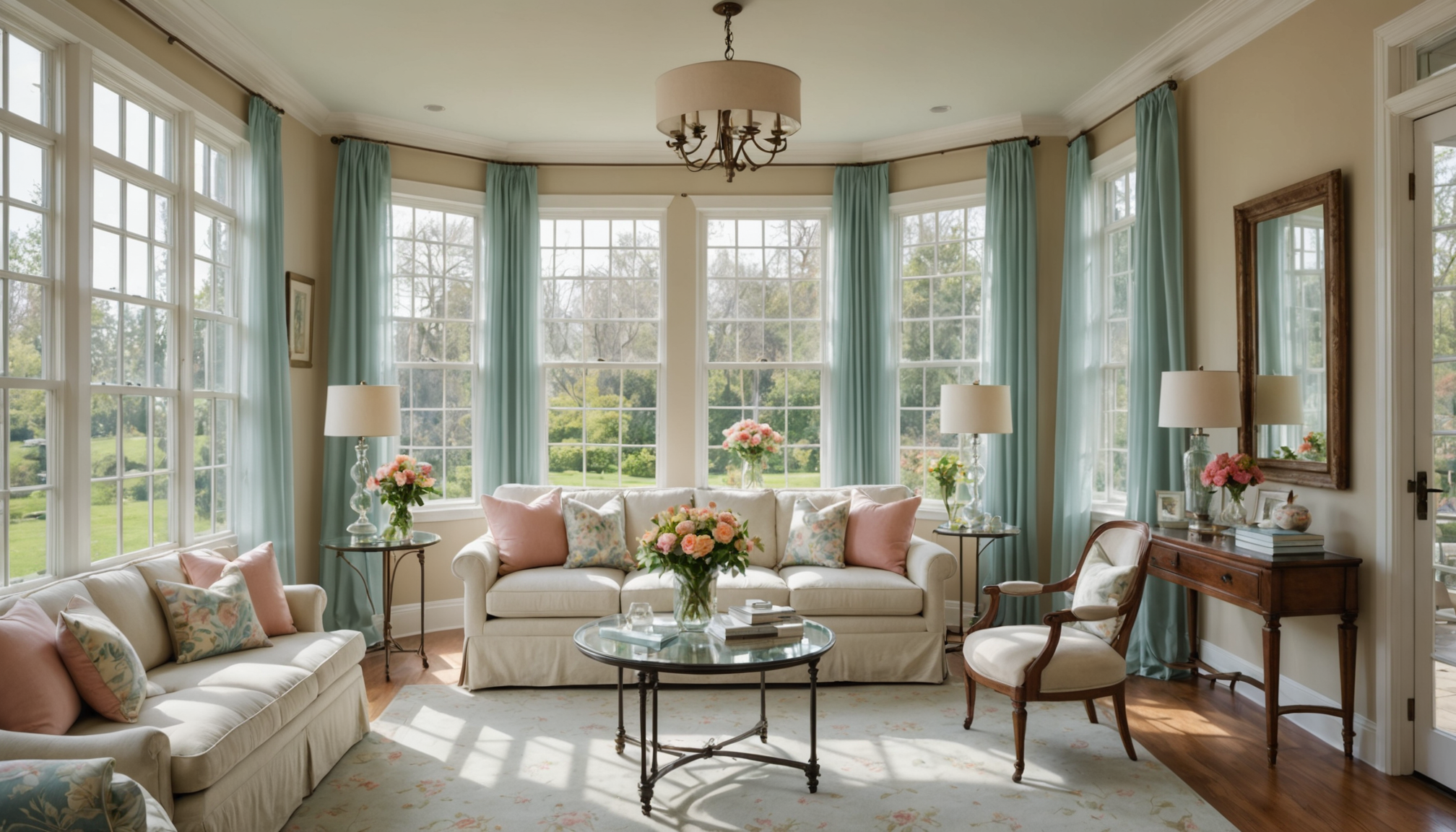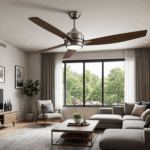When decorating your sunroom, maximizing natural light is key to creating a bright and airy space that feels connected to the outdoors. By focusing on how to harness and enhance this light, you can transform your sunroom into a welcoming retreat that remains vibrant throughout the day.
Start by considering the window treatments you use. Opt for sheer curtains or blinds that allow sunlight to filter through while maintaining privacy. These can be paired with heavier drapes that can be drawn in the evening or during particularly sunny days to control glare and protect furnishings from UV damage. Sheer fabrics will not only keep the sunroom well-lit but add an element of elegance to your decor.
The color scheme you choose can also play a significant role in maximizing the natural light available. Light colors, such as whites, creams, or soft pastels, reflect sunlight and contribute to a brighter environment. Consider painting the walls in a light, neutral hue, and select furniture pieces that complement this palette to maintain a cohesive look.
Mirrors are another effective tool for enhancing natural light. Strategically placing mirrors on walls opposite windows can reflect sunlight throughout the room, making the space feel larger and more open. Additionally, opting for glass or translucent furniture, such as a glass-topped table, can help to minimize visual barriers and allow light to pass through freely.
It’s important to periodically assess the cleanliness of your windows, as dirty or streaked glass can significantly reduce the amount of light that enters the room. Establish a regular window maintenance routine to ensure they’re always spotless, considering hiring pros if your sunroom features complex or hard-to-reach window styles.
To better understand how different window treatments and color palettes impact natural light in a sunroom, consider the following comparison of options:
| Option | Benefits | Drawbacks |
| Sheer Curtains | Allow light penetration, privacy maintained | Limited sunblock for intense light or privacy |
| Roller Shades | Easy light control, modern look | May block too much light when fully pulled down |
| Light Paint Colors | Reflects light, brightens space | Requires more frequent cleaning in high-traffic areas |
| Mirrors | Reflects light, creates illusion of more space | Can require careful placement to avoid glare |
Through these thoughtful choices, you’ll be able to maximize the natural light in your sunroom, ensuring that it remains a bright, inviting space that bridges the indoors and outdoors beautifully. This approach is not only beneficial for aesthetics but also for energy efficiency, reducing the dependence on artificial lighting and creating a more sustainable living space.
choose versatile furniture
When selecting furniture for your sunroom, choosing versatile pieces is essential to ensure that the space is both functional and aesthetically pleasing. Here’s a step-by-step guide to help you select the best versatile furniture for your sunroom:
1. Consider Multi-Functional Furniture:
– Look for pieces that serve multiple purposes. For instance, a daybed can be used for lounging during the day and doubles as a guest bed. Ottomans with built-in storage are perfect for keeping blankets or magazines out of sight while serving as extra seating or a coffee table.
2. Prioritize Lightweight and Portable Options:
– Opt for furniture that is easy to move for when you need to change the layout or create more space for gatherings. Wicker or rattan pieces are both stylish and lightweight, making them easy to rearrange based on your needs.
3. Choose Weatherproof Materials:
– Since the sunroom can often experience changes in temperature and humidity, it’s important to select furniture made from weather-resistant materials. Teak, metal, and resin wicker are durable options that can withstand the conditions in a sunroom.
4. Incorporate Flexible Seating Arrangements:
– Modular seating, such as sectional sofas, allows you to adapt the layout based on the occasion—whether it’s a quiet afternoon retreat or a lively social gathering. Being able to reconfigure your seating setup ensures that your sunroom is always ready for any activity.
5. Opt for Neutral and Complementary Colors:
– When selecting cushions and upholstery, choose versatile colors and patterns that can easily be refreshed with new accent pillows or throws. Neutrals like beige, gray, or soft pastels work well, allowing you to change the decor seasonally without having to replace large furniture pieces.
6. Select Easy-to-Clean Fabrics:
– Consider maintenance when choosing upholstery. Options like microfiber or those with removable, washable covers are practical for a space that might be accessed with damp swimwear or muddied shoes.
7. Incorporate Expandable Furniture:
– Tables with drop leaves or extensions are excellent for adapting to your needs, from intimate meals to large family dinners. This flexibility ensures you can comfortably entertain or have relaxed lunches in your sunroom.
By carefully selecting versatile furniture pieces, you will be able to decorate your sunroom in a way that meets your lifestyle needs while providing the flexibility to adapt over time. This thoughtful approach ensures you create a space that remains functional, comfortable, and stylish, all without the need for frequent updates.
incorporate cozy textiles
A sunroom presents an ideal opportunity to merge indoor comfort with the serenity of the outdoors, and incorporating cozy textiles is a must to enhance its allure. These soft furnishings can dramatically transform the atmosphere of your sunroom, ensuring that it’s not only visually appealing but also a comforting space to unwind.
Begin by selecting an assortment of plush cushions and throws in varied textures. These can include materials like velvet, chenille, or chunky knits to create a sense of warmth and depth. By layering these cozy elements on your seating arrangements, you immediately invite relaxation, making your sunroom a go-to spot for reading or enjoying afternoon naps. An assortment of fabrics not only adds visual interest but also offers tactile pleasure, contributing to a more welcoming environment.
Sourcing high-quality rugs is another effective way to incorporate textiles into your sunroom. These additions not only provide foot comfort but also help delineate spaces, creating an intimate atmosphere. Opt for natural fibers like wool or sisal for a touch of luxury, or choose colorful patterns to add vibrancy to your decor. Rugs with robust patterns or hues can also help hide wear and tear from foot traffic, making maintenance less of a hassle.
Curtains and drapes bring added coziness while offering functional benefits, such as controlling the amount of sunlight entering the room. Opt for fabrics that offer both opacity for privacy and sheer options to filter natural light beautifully, complementing the theme of the sunroom while also safeguarding furniture from prolonged sun exposure.
Integrating textiles isn’t just about comfort and aesthetics; it also has practical benefits when it comes to acoustics. Soft materials can absorb sound, reducing echoes and creating a more pleasant auditory environment. This is particularly beneficial if your sunroom doubles as a multi-purpose room or an entertainment area where clear acoustics enhance the experience.
By thoughtfully decorating with cozy textiles, you’ll not only enrich the décor but also ensure your sunroom is a haven of comfort year-round, regardless of the season. This attention to detail in your choice of textiles also reflects a considered approach to home decorating, where beauty and practicality go hand in hand.
add greenery and plants
To truly breathe life into a sunroom, incorporating an array of greenery and plants is essential. Infusing nature in this way not only enhances the serene connection to the outdoors, but also contributes to a fresher, more vibrant atmosphere. Plants have an innate ability to soften spaces, adding elegance and tranquility while also absorbing toxins from the air for a healthier environment.
Start by assessing the amount of natural light that your sunroom receives throughout the day. This will help you determine the most suitable types of plants. For sunny spots, opt for sun-loving plants like succulents, cacti, or lavender, which thrive in bright conditions and require minimal maintenance. Conversely, if you have shaded areas, consider ferns, peace lilies, or snake plants, which excel in lower-light environments.
To add layers and depth to your decor, think about incorporating plants of varying heights and textures. Tall, sculptural plants like fiddle-leaf figs or rubber trees can create striking focal points, drawing the eye upward and adding vertical interest. Meanwhile, trailing varieties such as pothos or string-of-pearls can be placed on shelves or hung from the ceiling, introducing a touch of whimsy and movement.
Plant stands and decorative pots are excellent tools to seamlessly blend your greenery with the existing decor. Choose planters that complement the color scheme and style of your sunroom, whether that be rustic terra cotta for a cozy, natural look or sleek ceramic pots for a more contemporary vibe. Mixing and matching different materials and finishes can also add to the visual appeal, creating a dynamic arrangement that highlights each plant’s unique beauty.
Consider the benefits of hiring pros for advice on plant care and arrangement, especially if you’re new to indoor gardening. They can offer valuable insights into selecting the best plants for your space and provide tips on watering schedules, soil types, and pest prevention to ensure your plants not only survive but thrive.
Maintain a regular routine for plant care to keep your green oasis looking lush and lively. Remember to dust leaves gently with a damp cloth to facilitate photosynthesis and remove any dead or yellowing foliage to promote new growth. Adjust your watering habits with the changing seasons, as different times of the year may require more or less moisture.
By thoughtfully integrating greenery into your sunroom, you consciously enhance its aesthetic appeal while fostering a healthier, more inviting ambiance. This approach to decorating seamlessly merges the indoors with the natural world, crafting a harmonious retreat that refreshes both the eyes and the spirit.
create a functional layout
To make the most of your sunroom, it’s essential to design a functional layout that maximizes both comfort and usability. Begin by envisioning how you plan to use the space on a daily basis, as this will guide your decisions in arranging furniture and decor. Consider the activities you’ll engage in—whether it’s leisurely reading, entertaining guests, or pursuing hobbies—and plan your layout to accommodate these interests seamlessly.
Start by setting a focal point to anchor the room, such as a stylish coffee table or a statement piece of art. This helps to naturally draw the eye and organize the surrounding furniture. Arrange seating around this point to facilitate conversation and provide easy access to any accompanying features like a bookshelf or media center. If your sunroom serves multiple functions, think about using area rugs to delineate different zones for different purposes, ensuring that each area feels intentional and cohesive.
Ensure that traffic flow within the sunroom is unimpeded, allowing for smooth movement between the indoors and outdoors. This might mean arranging furniture in a manner that preserves pathways to doors or creating a strategic flow around the room’s perimeter. By minimizing obstacles, you’ll maintain a sense of openness and ease within the space.
Incorporating multi-functional elements like foldable tables or modular sofas can add versatility, allowing you to easily reconfigure the layout for different occasions—be it a quiet afternoon alone or a bustling family gathering. These adaptable pieces make it possible to reinvent the room’s functionality with minimal effort and expense.
Once your layout is established, pay attention to balance and proportion, ensuring that larger pieces aren’t overwhelming the space. Accessorize thoughtfully with items that enhance the room without adding clutter, and be strategic in the placement of lighting to highlight key areas while maintaining a welcoming ambiance. Ceiling fixtures, floor lamps, and adjustable sconces can all contribute to a layered lighting design that complements the room’s natural light.
Furthermore, consider maintenance needs when finalizing your layout. Easy-to-clean surfaces and dust-free zones facilitate upkeep, ensuring that your sunroom always looks polished with minimal effort. Include plenty of storage options to hide away less attractive elements and maintain a tidy look, just as effective arrangements cater to daily use.
By carefully crafting a functional layout tailored to your lifestyle, your sunroom becomes more than just a transitional space—it’s a personalized sanctuary that supports both relaxation and productivity, connecting you to nature and rejuvenating your living environment.
In conclusion, by strategically employing these decorating tips in your sunroom, you achieve a seamless balance of style and practicality. Each element, from versatile furniture to cozy textiles and invigorating greenery, contributes to a serene space that harmonizes with the beauty of the outdoors. This effort not only elevates the aesthetic appeal but also enhances the functionality of your sunroom, creating a cherished retreat that brings joy and comfort year after year.


